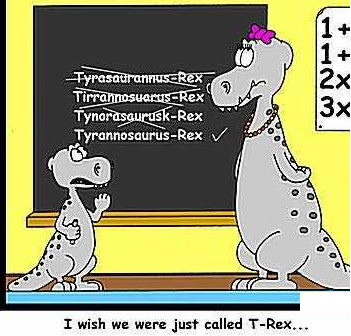- Regresar a la página principal »
- T. REX IS STILL KING
Posted by : Unknown
22 jun 2012
Palaeontologists fought back on Wednesday in a spirited debate over the Tyrannosaurus rex, saying revisionists who branded the great dinosaur a shameless scavenger have got it all wrong.
For more than a century after its discovery, many scientists routinely described the Tyrannosaurus as the king of the killing machines -- six tons of teeth, muscle and sinew, designed to run down dinos several times its size and shred them.
But over the last decade, a new wave of T. rex scholarship has painted another, less flattering, picture.
T. rex, according to this theory, was just a 12-meter (40-foot) freeloading lizard that was too clumsy and slow to do its own hunting.
It simply barged in on a meal after nimbler predators had done all the dirty work -- in other words, it was more hyena than lion.
The first broadside on the carnivore's predatory credentials came in 2003, when American expert Jack Horner concluded that T. rex's clawless forearms, beady eyes and lumbering legs meant it was "100 percent scavenger."
In 2007, John Hutchinson of the Royal Veterinary College in Britain dished out another blow, demonstrating the "clunky" dinosaur needed more than two seconds to pivot 45 degrees, making it easy for would-be prey to evade capture.
But a new study, published in the Proceedings of the Royal Society B: Biological Sciences, may help redress the balance.
Chris Carbone of the Zoological Society of London and colleagues say that some of the traits that raised doubts about T. rex's predatory prowess are larded with ambiguity.
An enhanced sense of smell, inferred from enlarged olfactory bulbs, is a common trait among scavengers such as vultures -- but it can help a hunter too, they note.
T. rex's eyes, it turns out, are not that small after all, and its binocular vision -- along with its crushing bite and impact-resistant teeth -- are all well adapted for killing.
But Carbone's most most persuasive argument for predation has nothing to do with the giant theropod's physical traits.
"We took an ecosystem approach, establishing a complete list of all the species in the area," he explained by phone.
"What is novel is that we make inferences about abundance from the size of the animals" in the Late Cretaceous, he said, referring to the period 85 to 65 million years ago when T. rex reigned supreme.
Drawing from fossil records and studies of fauna distribution in East Africa's Serengeti plains today, Carbone calculates that the ecosystem at the time would have been overwhelmingly populated by smaller dinosaurs.
Among carnivores, 80 percent would have weighed about 20 kilos (45 pounds), and T. rex would have accounted for only 0.1 percent of the population.
Among herbivores -- generally heavier -- about half weighed in at about 75 kilos (165 pounds).
The researchers calculated the range in which T. rex could roam on a daily basis, how many dead dinosaurs of different sizes it was likely to come across, and what other foragers might be around.
"Given the distribution of carcasses and the potential competition with other carnivorous dinosaurs, it is extremely unlikely that an adult T. rex could use scavenging as a long-term sustainable foraging strategy," the study concludes.
Carbone points out that modern-day wild dogs and hyenas -- similar in size and relative abundance as the smaller dinosaurs of the Late Cretaceous -- "can reduce a 70-kilo (154-pound) carcass to scraps of skin and bone extremely rapidly, certainly under an hour."
The consequences for a slow-moving scavenger would have been dire.
Even if T. rex could easily push aside other predators, once it arrived at a kill scene, more agile, fleet-footed meat-eaters would have probably picked the bones clean by the time it arrived.








